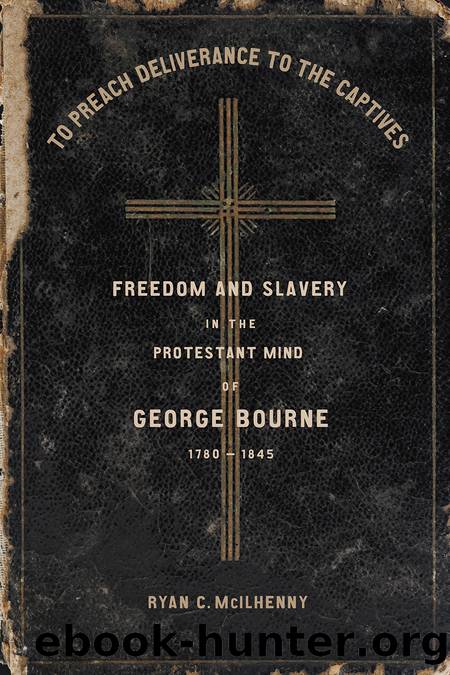To Preach Deliverance to the Captives by Ryan C. McIlhenny

Author:Ryan C. McIlhenny
Language: eng
Format: epub
Publisher: LSU Press
Published: 2020-01-15T00:00:00+00:00
CHAPTER 5
ABOLITION AND THE WOMAN QUESTION
IN BOURNEâS Slavery Illustrated in Its Effects on Woman and Domestic Society
To all the members of female abolitionist societies, with profound solicitude, that those sisters in philanthropy may be stimulated to untiring exertions in behalf of twelve hundred thousand women, who are now chained in the American house of bondage.
âGEORGE BOURNE, Slavery Illustrated in Its Effects on Woman and Domestic Society
On May 19, 1840, William Lloyd Garrison embarked on his journey to the World Anti-Slavery Convention, which was to be held the following month in London. This gathering would not only have a tremendous impact on the efforts to end slavery, it would also expand the idea of participatory democracy by giving birth to the womenâs rights movement. Unfortunately, the Columbus, the ship on which Garrison was to travel, had been anchored in New York and was delayed due to inclement weather, making the fiery Bostonian late to the opening session of the convention. While in New York, he wrote to his wife Helen Eliza about the upcoming London gathering and the labors of the American Anti-Slavery Society, now divided over the issue of the âwoman question,â to send delegates, including Lucretia Mott, to be seated at the convention. He anticipated what would be a hard-fought battle for those, including his wife, who supported women leadership in the antislavery cause. Bourne, who was also in New York at the time, kept company with Garrison on that very day. The two discussed the rights of women. âFather Bourne,â Garrison wrote to Eliza, âgoes against âwomanâs rightsâ . . . and he predicts, with all confidence, that no woman will be allowed a seat at the Convention. Such a thing, [Bourne] says, was never heard or thought of in any part of Europe.â1 Apparently, Bourne had counseled Garrison against putting his hopes in securing the place of women in the movement. Although encouraging women to get involved in the movement to eradicate slavery, Bourne was certainly not as radical or forward looking on the âwoman questionâ as were other antislavery associates. He did not, however, adopt the position that womenâs more public leadership role in immediatism was grounds enough for the division that had occurred among American abolitionists. Garrison may have been a bit too quick to judge Bourneâs opinion on womenâs rights.
By 1834, George Bourne included women among the âtwo classes of personsâ (along with ministers) whose duty it was to âcombine their energies, cry aloud, spare not and never cease, till the thralldom of American citizens [slaves] has been dismissed to that bottomless pit.â2 His Slavery Illustrated in Its Effects on Woman and Domestic Society was published in 1837, a year in which antislavery organizing by northern women reached a high point. According to Beth Salerno, these societies sprang up in rapid succession following the example of the first African American planned Female Antislavery Society of Salem, Massachusetts. Seventeen were established by 1834, âtwenty-nine in 1835, forty-one in 1836, and a record forty-five in the peak year of 1837.
Download
This site does not store any files on its server. We only index and link to content provided by other sites. Please contact the content providers to delete copyright contents if any and email us, we'll remove relevant links or contents immediately.
| United States | Abolition |
| Campaigns & Battlefields | Confederacy |
| Naval Operations | Regimental Histories |
| Women |
In Cold Blood by Truman Capote(3305)
Steve Jobs by Walter Isaacson(2830)
The Innovators: How a Group of Hackers, Geniuses, and Geeks Created the Digital Revolution by Walter Isaacson(2827)
All the President's Men by Carl Bernstein & Bob Woodward(2326)
Lonely Planet New York City by Lonely Planet(2169)
And the Band Played On by Randy Shilts(2127)
The Room Where It Happened by John Bolton;(2102)
The Poisoner's Handbook by Deborah Blum(2089)
The Murder of Marilyn Monroe by Jay Margolis(2055)
The Innovators by Walter Isaacson(2046)
Lincoln by David Herbert Donald(1943)
A Colony in a Nation by Chris Hayes(1880)
Under the Banner of Heaven: A Story of Violent Faith by Jon Krakauer(1745)
Amelia Earhart by Doris L. Rich(1645)
The Unsettlers by Mark Sundeen(1641)
Birdmen by Lawrence Goldstone(1618)
Dirt by Bill Buford(1609)
Being George Washington by Beck Glenn(1607)
Zeitoun by Dave Eggers(1586)
